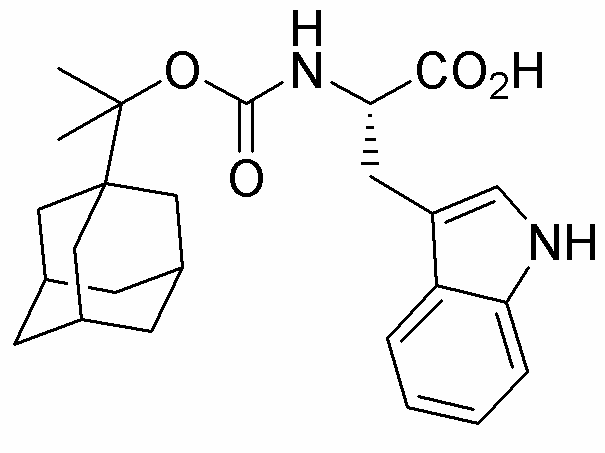(1-{1'-Adamantyl}-1-methyl-ethoxycarbonyl)-L-tryptophan is widely utilized in research focused on
- Pharmaceutical Development: This compound is explored for its potential in developing new medications, particularly in the treatment of neurological disorders, due to its ability to cross the blood-brain barrier effectively.
- Peptide Synthesis: It serves as a valuable building block in peptide synthesis, allowing researchers to create complex peptides with enhanced stability and bioactivity, which are crucial for drug design.
- Biotechnology: In biotechnology, it is used to modify proteins, improving their function and stability, which can lead to more effective biopharmaceuticals and diagnostic tools.
- Research in Neuroscience: The compound is studied for its role in neurotransmitter modulation, providing insights into brain function and potential therapeutic targets for mental health conditions.
- Cosmetic Formulations: Its unique properties make it a candidate for use in cosmetic products, where it can enhance skin penetration and improve the delivery of active ingredients.
General Information
Properties
Safety and Regulations
Applications
(1-{1'-Adamantyl}-1-methyl-ethoxycarbonyl)-L-tryptophan is widely utilized in research focused on
- Pharmaceutical Development: This compound is explored for its potential in developing new medications, particularly in the treatment of neurological disorders, due to its ability to cross the blood-brain barrier effectively.
- Peptide Synthesis: It serves as a valuable building block in peptide synthesis, allowing researchers to create complex peptides with enhanced stability and bioactivity, which are crucial for drug design.
- Biotechnology: In biotechnology, it is used to modify proteins, improving their function and stability, which can lead to more effective biopharmaceuticals and diagnostic tools.
- Research in Neuroscience: The compound is studied for its role in neurotransmitter modulation, providing insights into brain function and potential therapeutic targets for mental health conditions.
- Cosmetic Formulations: Its unique properties make it a candidate for use in cosmetic products, where it can enhance skin penetration and improve the delivery of active ingredients.
Documents
Safety Data Sheets (SDS)
The SDS provides comprehensive safety information on handling, storage, and disposal of the product.
Product Specification (PS)
The PS provides a comprehensive breakdown of the product’s properties, including chemical composition, physical state, purity, and storage requirements. It also details acceptable quality ranges and the product's intended applications.
Certificates of Analysis (COA)
Search for Certificates of Analysis (COA) by entering the products Lot Number. Lot and Batch Numbers can be found on a product’s label following the words ‘Lot’ or ‘Batch’.
Numéro de catalogue
Numéro de lot/série
Certificates Of Origin (COO)
This COO confirms the country where the product was manufactured, and also details the materials and components used in it and whether it is derived from natural, synthetic, or other specific sources. This certificate may be required for customs, trade, and regulatory compliance.
Numéro de catalogue
Numéro de lot/série
Safety Data Sheets (SDS)
The SDS provides comprehensive safety information on handling, storage, and disposal of the product.
DownloadProduct Specification (PS)
The PS provides a comprehensive breakdown of the product’s properties, including chemical composition, physical state, purity, and storage requirements. It also details acceptable quality ranges and the product's intended applications.
DownloadCertificates of Analysis (COA)
Search for Certificates of Analysis (COA) by entering the products Lot Number. Lot and Batch Numbers can be found on a product’s label following the words ‘Lot’ or ‘Batch’.
Numéro de catalogue
Numéro de lot/série
Certificates Of Origin (COO)
This COO confirms the country where the product was manufactured, and also details the materials and components used in it and whether it is derived from natural, synthetic, or other specific sources. This certificate may be required for customs, trade, and regulatory compliance.


